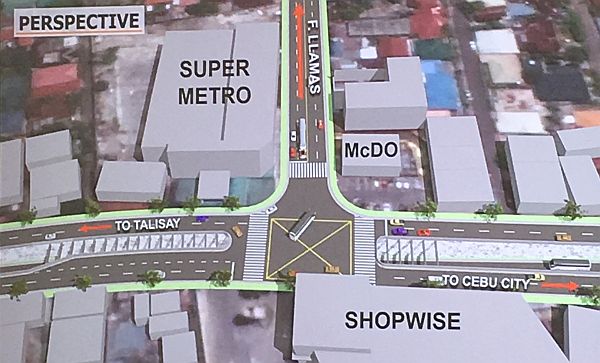
This is how the P683 million underpass project in the intersection of N. Bacalso Ave. and F. Llamas St. in Cebu City will look like once construction is completed by the DPWH 7 and its contractor. Construction will start this month and is expected to be done within 18 months.
CONTRIBUTED PHOTO/DPWH 7
Two-day rerouting scheme to affect 8 southern villages
Leave your houses early to avoid being late since traffic is going to be heavy along N. Bacalso Ave. in Cebu City for two days.
Starting tomorrow, the Cebu City Transportation Office (CCTO) and the Department of Public Works and Highways in Central Visayas (DPWH-7) will hold a dry run on the rerouting scheme for public utility jeepneys (PUJs) to give way to the construction of a P683-million underpass project at the intersection of N. Bacalso Ave. and F. Llamas St.
Since no vehicle would be allowed to pass the “construction site” starting 5 a.m., traffic would be heavy along the route especially that classes in public schools have already started.
“My advice is for people to leave their homes earlier (than usual) and as much as possible, avoid having to pass through the area so that you won’t be caught in the traffic,” said CCTO operations chief Francisco Ouano.
At least 45 traffic enforcers would be deployed in the alternative roads within the project site during the dry run on Wednesday and Thursday.
Tanods from the eight affected barangays would be deputized by the CCTO to help apprehend violators whose vehicles may impede traffic flow in the area.
The rerouting will affect Barangays Mambaling, Labangon, Tisa, Punta Princesa, Quiot, Basak Pardo, Cogon Pardo and Basak San Nicolas which are near the project site.
Depending on the results of the two-day dry run, the DPWH-7 contractor may already start mobilizing their equipment for the first phase of the underpass project by next week.
The project, a joint venture with Cedco Engineers Consortium, was awarded to WT Construction Inc.
First phase of the project will involve the southbound lanes of N. Bacalso Ave. at the portion in front of Mcdonald’s in Barangay Mambaling.
The first phase is expected to last for around three to four months. This means the entire project will be finished in at least 18 months.
Based on the final design, the entire project will be 700 meters long. But the actual underpass, or technically referred to as a depressed structure, will be only 620 meters. It will also have a vertical clearance of 5.2 meters.
The underpass will hold a sump tank, which will store runoff water so rainwater will not flow to the depressed portion. The stored water will then be pumped into the drainage line, which is among the components of the project.
Upon completion, the depressed portion will have two lanes — one going southbound and the other, northbound.
This will accommodate vehicles going from Cebu City to the south and vice versa while passing just straight through N. Bacalso Ave.
On each side of the depressed portion will also be two-lane streets which can accommodate vehicles that will turn to and from F. Llamas St.
“After two days, maybe we will see what else needs to be done. In the first day, maybe a lot of motorists will be surprised. But after two days, they will be able to adjust and get accustomed already. They can find their own routes already,” said Roy dela Cruz, DPWH-7 project engineer.
Private vehicles are not directly affected by the PUJ rerouting scheme since drivers of private vehicles can choose their own preferred routes depending on their starting point and destination.
Only vehicles coming from Cebu City going south will be directly affected by the first stage of the project since those from the south going to Cebu City could still use the northbound lanes of N. Bacalso Ave.
The DPWH-7 is asking the public to support the project and be patient with the expected inconvenience that will be brought by the rerouting.
“Let’s just help each other. We will be coordinating with everyone concerned,” Dela Cruz said.
He advised motorists to follow traffic direction and signs that would be put up in the area.
“Leave your homes earlier, maybe by an hour or 30 minutes. Bear with us for this temporary inconvenience. As work progresses, surely our traffic will improve,” he added.
Dela Cruz said they started talking with officials of two schools located along the project site.
One is Don Vicente Rama Memorial National High School, which is located near the highway in Barangay Basak San Nicolas.
The other is the University of San Jose-Recoletos (USJ-R) Basak Campus.
Dela Cruz said they already informed the officials of the two schools about the traffic dry run.
He said they also talked to the village chiefs of barangays affected by the project to help disseminate information about the dry run as well as the specific traffic rerouting scheme.
“We will just observe on Wednesday. We will look at the traffic flow. For sure, there will be disruption. There will be a little inconvenience. We will just have to adjust,” Dela Cruz said.